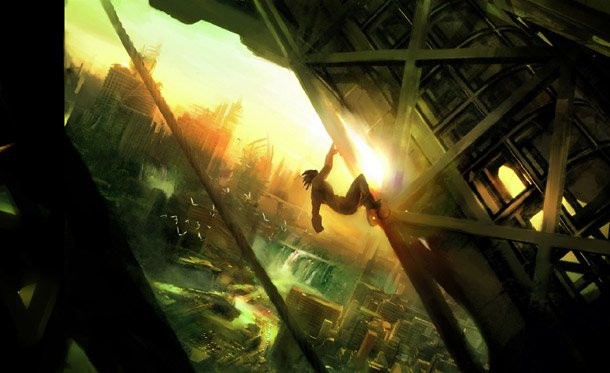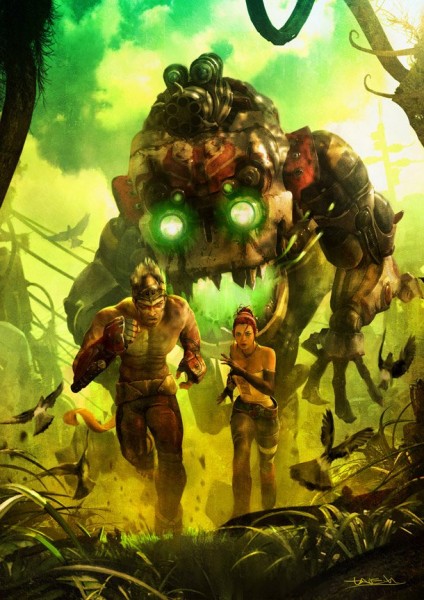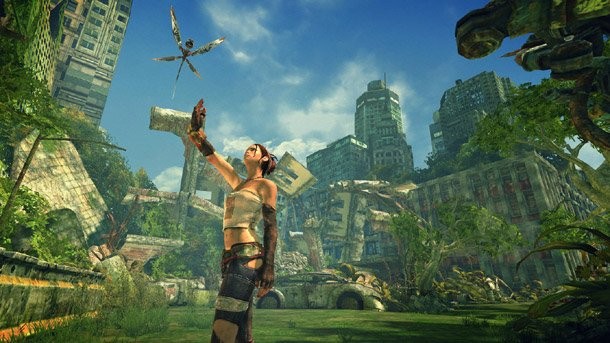Please support Game Informer. Print magazine subscriptions are less than $2 per issue
Heavenly Sword Dev Goes Apocalyptic

One hundred and fifty years into the future, there are no wars. Not because we stopped fighting – there are no longer enough people left to fight wars. With humanity nearly extinct, once-great cities teeming with people now lay empty and overrun by nature. Giant mechanical airships troll across the countryside, snatching up the remaining inhabitants and carting them out west. You lived a lonely life, always on the run, always one step ahead of the machines – until she came along. She inserted herself into your life and disrupted everything. Now she wants you to be her protector. She wants you to travel beside her and safeguard her on a long journey back to her village. You are going to do as she asks. Not because you want to. Not because you like her. But because if you don’t, the small headband strapped to your skin will shatter your skull. You must obey. You are enslaved.
There is a belief among psychologists called the 7%-38%-55% Rule. This principle breaks down how human beings understand information during an emotional exchange. Simply put, the theory postulates that when somebody is speaking only seven percent of their emotions are displayed in the words they say, while roughly 38 percent of their emotional intent can be derived from the tone of a their voice, and a surprising 55 percent comes from physical cues such as body language and facial expressions. What we say isn’t what we’re saying; it’s how we’re saying it that states our true meaning.
Storytellers understand the importance of an expression, because 55 percent is a lot of information to lose. If the rule is applied to gaming, it means that video game stories have never maximized their emotional impact. Voice actors do their best to bring pathos to a role, but there is only so much sentiment one can give a cardboard cutout. Until the current console generation, video games just didn’t have the technical muscle to allow their characters a full range of human expression. The ability to animate a digital face has grown by leaps and bounds in recent years, introducing emotionally vibrant stories for the first time.
One developer leading the charge to bring more humanity into its digital creations is Ninja Theory. The studio’s 2007 release, Heavenly Sword, remains a brilliant showcase for humanlike physicality in the digital realm. The impressive cutscenes and stylish combat wowed many critics, and even today, its characters’ facial animations hold up as some of the best in the business. Since the release of Heavenly Sword, Ninja Theory has been hard at work on its next IP, Enslaved. But more important to the studio than just making another highly polished action title is telling the meaningful story that happens between the action.
[This story first appeared in issue 198 of Game Informer Magazine -Ed.]

Andy Serkis is no stranger to working in the digital space. The actor – famous for bringing Gollum to life in the Lord of the Rings films and performing the motion capture for King Kong in the Peter Jackson remake – worked closely with Ninja Theory on Heavenly Sword. Not only did Serkis voice the antagonist, King Bohan, he was instrumental in the casting process and directed all of the game’s cutscenes. For Enslaved, Ninja Theory asked Serkis to return to the director’s chair, where he helped cast the entire ensemble, fleshed out much of the story, and even gave voice to the title’s protagonist, Monkey.
“Looking back at Heavenly Sword, it feels like we were taking the first steps towards bringing emotionally engaging characters through a traditional game design keyhole,” Serkis tells us. “This time our sights were set beyond creating dramatically compelling cutscenes and focused on the higher goal of trying to redefine how storytelling might work in games.”
The character Monkey – which Serkis has also done all the motion capture for – lives in a far different world than the one we recognize. Almost two centuries into the future, humanity has suffered through the third and fourth World Wars. Economic disasters ruined once powerful nations. Famine and disease ravaged urban landscapes. All this turmoil has resulted in a massive population crash. Where cities filled with millions of people were once common, in Monkey’s time only roughly 100,000 people live spread across North America. The humans who do still exist are too isolated from one another to share a common culture.
Monkey is a man of the wilderness. Like the self-sustaining fur traders from the 19th century, he prefers to stay away from the few pockets of humanity that dot the countryside. “Monkey is a guy who’s spent all his life learning to survive on his own, destroying robots with his bare hands. He’s not the kind of guy you want to get in a fight with,” says Tameem Antoniades, the co-founder, co-director, and design lead at Ninja Theory. Whoever raised Monkey trained him to stay away from clusters of people because they were the ones most likely to get attacked by the roving slave ships – ancient remnants of a long-ceased conflict.
Monkey can’t hide forever, though, and the game starts just after he’s imprisoned inside one of these giant ships. This is where he meets a young girl named Trip. “Trip’s really the opposite of Monkey,” Antoniades says. “Where Monkey is brutish and alpha, she’s very educated, and she’s all about the community. She’s good with machinery; her community is great at scavenging equipment and hacking the technology.”
Trip helps Monkey escape from the slave ship by hacking into its controls and causing the vessel to crash. In this opening level, players control Monkey as the two perform their escape. “The escape sequence is a tutorial where you learn the basics of combat and movement,” Antoniades explains. “But it won’t look like a tutorial at all. As you’re escaping the slave ship everything is basically short circuiting and breaking apart. You’re flying over the sea and then you can see New York City underneath. The whole time you’re just trying to get to safety. It’s really intense.” As the ship crashes through some of the massive skyscrapers, Monkey blacks out.
He wakes up in the middle of Grand Central Station as Trip cowers in the corner. She used the time Monkey was unconscious to reprogram a slave collar, which she placed on his forehead. She has noticed how resourceful Monkey is, but she knows he won’t willingly help her return to her village, so she forces him into compliance on threat of death. “You’ve got this character that effectively has control over you, but who totally depends on you to rescue her,” Antoniades says. This tension creates an interesting dynamic that leaves the two in an uneasy alliance. Monkey doesn’t like having another person around, and he isn’t happy about being used. It’s insinuated that as soon as Monkey helps Trip get back to her village and she takes off his headband, he’s going to rip her head off.

To tell a story on the level Ninja Theory wanted, it needed to bring in someone who not only understands video games, but knows how to tell a compelling narrative. Serkis was instrumental in fleshing out many of the games characters, but for the full script, Ninja Theory needed a professional writer. The team approached screenwriter Alex Garland (28 Days Later, Sunshine) and asked him if he’d be interested in working on Enslaved. A huge gamer, Garland agreed, and sat down to pen every line of dialogue. “Every week Alex would come to the office and we’d sit down with the design team and we’d work through the level layouts,” Antoniades says. “The gameplay and story are interlinked. They are one. Stories aren’t just in cutscenes, they go throughout the level.”
This blending of story and gameplay is demonstrated as Monkey and Trip explore New York’s skeletal streets. As Garland helped envision, the two have no concept of what the past was like, and they often misinterpret the things they see in the world around them.
As the two leave Grand Central Station, Trip notices all the windows among the cliffs they’re walking beside and wonders aloud, “what is this place?” After puzzling over it for a second she realizes that they are in what was once a city. “There must have been thousands of people here,” she exclaims.
Monkey responds curtly, in a gruff voice, “No, more.”
Trip pauses a second then asks, wide-eyed, “Tens of thousands?”
“Maybe,” Monkey shrugs.
These characters have no clue that they are walking through streets that once housed millions. Through their dialogue, which is scattered through all parts of the game, players get a glimpse into just how far from contemporary society humanity has fallen.
“The game is driven by the relationship between these two characters,” Antoniades says. “Heavenly Sword was obviously very story driven, but we wanted to take that to the next level where as a player you’ve got this deep, connected relationship with this NPC character that has her own mind, her own thoughts, her own personality.”

Though Monkey and Trip may not get along, if they want to survive they must work together. Trip can help Monkey solve environmental puzzles by squeezing through passages too narrow for him, or hacking computers. Monkey can toss Trip across gaps and help her reach otherwise inaccessible areas. Although Ninja Theory has no plans to include a co-op feature, Monkey can issue rudimentary commands to Trip. For example, he can tell her to distract a turret gun so that he can quickly run up behind the nuisance and dismantle it.
While a portion of the game involves climbing over obstacles and exploring multiple paths through environments, few of those routes are free from danger. The world is still littered with weapons from ancient conflicts. The studio compares these weapons to landmines – they’ve been waiting years for someone to walk by and trip them awake. However, unlike landmines, these weapons are human-sized robots programmed to kill. “There are different generations of robots,” Antoniades explains. “There are the older robots, which are more like the ones you would expect in a movie with pistons and things like that, then there are the more evolved second and third generation robots. They have synthetic muscles and coolant in their bloodstreams. They’re much more agile, much more dangerous, more like hunters.” To get past these kinds of threats, Monkey must rely on Trip.
Trip has a special camera she keeps in her hair like a barrette that’s really a mechanical dragonfly. This camera can fly around the environment and feed information directly into Monkey’s headband. It’s useful for helping the two navigate their surroundings, and it also detects weaknesses in enemies. Even robots from similar production lines will have different imperfections after decades of wear and tear. If Monkey knows all of these defects he can use them to his advantage in combat.
Monkey’s primary weapon is a large staff. Similar to Heavenly Sword, players have one low attack button and a stronger charge attack with which to build up combos. A series of evades and grapple takedowns help Monkey maneuver through the battlefield. In addition, Monkey’s staff can fire off a few long-range projectiles, which will stun enemies or slow them down, giving Monkey time to close the gap.
Still, Ninja Theory hopes Enslaved’s action will feel more strategic than Heavenly Sword’s. This is where the enemy defects come into play. One enemy might have a weakness in its machine gun mountings. After depleting its health to a certain point, Monkey can rip off the gun and use it against the other robots he’s fighting.
Another robot might have a power supply problem, which Monkey could overload during the scuffle, turning the machine into a time bomb. Monkey can then kick the machine into a larger group of enemies causing splash damage. The order in which players dismantle their foes changes how each encounter plays out. “There are several different levels of combat,” Antoniades says. “There is the basic action – the button-based level of combat – and then there is tactical decision making. ‘Who should I go for first?’ You always have to think about ‘how can I beat these guys in a more clever way?’” Ninja Theory is planning dozens of these kinds of enemy takedowns, so players should have plenty of opportunities to experiment and see how using different weaknesses in conjunction affect their combat strategy.
As Monkey and Trip plot a path out of a dilapidated New York, the sights they see will become less recognizable for players. There is a place just outside of the city called the Titan Graveyard. “This is where the last big battle between mechs was fought,” Antoniades says. “Everything from first generation mechs to giant mechs almost the size of aircraft carriers. It feels like an elephant graveyard. There is still residual power in some of these machines, and you might see some of them twitching or moving around.” The atmosphere takes on a horrific feel as Monkey and Trip travel through this haunted place. They notice something following them, scuttling under the debris. They are about to face foes and see things they’ve never dealt with before.
Looking at the work Ninja Theory has put into crafting this world, it’s clear that the team cares about offering a compelling narrative. It has been lucky enough to recruit talent like Andy Serkis, Alex Garland, and Hollywood composer Nitin Sawhney to share that vision and help tell an emotionally charged tale.
“We’re not trying to say that we’re making a Hollywood blockbuster, because we’re not. We’re making a video game,” Antoniades says. “We’re taking the production of all aspects of video games very seriously; bringing in the best people we can find and working closely with them to make sure that every area of the game is as high production as we can possibly make it.”










